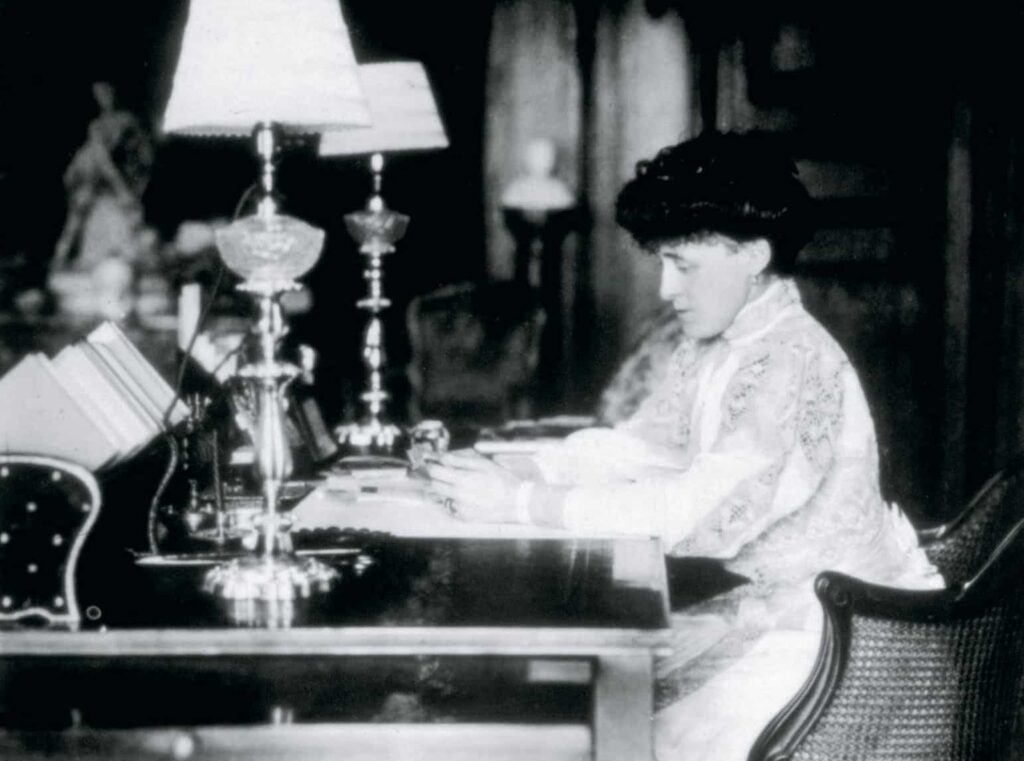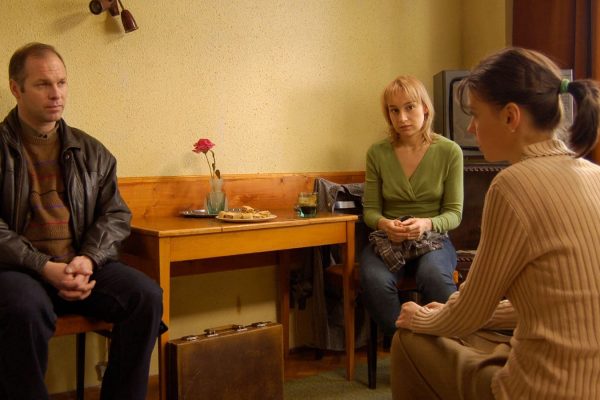Ghosts
Edith Wharton
New York Review Books, $16.95 (paper)
In 1902 American writer Edith Wharton and her husband Teddy purchased 113 acres of land in Lenox, Massachusetts, from Georgiana Sargent, an avid gardener and socialite. There Wharton would build The Mount, a sprawling estate, including majestic house and gardens, which she designed herself with the assistance of architects Ogden Codman, Jr., and Francis Hoppin. She would go on to write several books about design, including the surprise success The Decoration of Houses (1897)—and, in fact, in a letter to her lover Morton Fullerton, she expressed her belief that she was a better designer than novelist. The Mount represented a haven where Wharton could read, write, and socialize away from the most oppressive social constraints of her gender and class, though she lived there full time for only five years, from 1903 to 1908. Of her home she wrote in her autobiography A Backward Glance (1934), “It was only at The Mount that I was really happy.”
Wharton was born Edith Newbold Jones in 1862, and raised among New York elite, whose inner workings and manners she later captured in novels such as The House of Mirth (1905) and The Age of Innocence (1920). It’s said that the phrase “keeping up with the Joneses” stemmed from the prestige of her father’s family. Despite the milieu of wealth and comfort, Wharton had a difficult childhood. She struggled against the limits of her prescribed education and upbringing. Her parents were distressed by her need for solitude and privacy to read and imagine. “What I really preferred,” she writes, “was to be alone with Washington Irving and my dream.” At age nine she nearly died of typhoid, an episode which left her with “chronic fear” and general superstition, she says. For many years she slept with a light on in her room and a maid watching over her.
This disposition of unease followed her into adulthood. She married Edward Robbins Wharton (Teddy) in 1885; the two traveled extensively until Teddy’s depression anchored him to The Mount, a melancholy that seems to have bled into Edith’s psyche. Wharton lived some happy years there, famously writing in bed with her little dogs, but gradually became disillusioned with the house she had once loved, even coming to find it sinister and threatening. Her marriage deteriorated; after verbal abuse and violent episodes of hysteria on Teddy’s part and infidelity by both parties, Edith moved to Paris, and Teddy sold the house without her consent in 1911. They divorced two years later. Wharton would never again live in the United States.
So the symbol of her self-invention became something Wharton hated and feared. Amidst her marital and emotional turmoil, did Wharton really believe The Mount was haunted? Subsequent occupants shared her suspicions; some reported hearing strange noises and seeing spectral figures. The estate, now open to the public as a house museum, offers a popular ghost tour, promising the chance to see apparitions of past denizens, caretakers, groundskeepers, and tragic suicides.
But the question of Wharton’s own beliefs is perhaps the wrong one to ask. In the preface to Ghosts, Wharton adumbrates her view that belief in the supernatural is not an act of the intellect. Rather, it is “in the warm darkness of the pre-natal fluid far below our conscious reason that the faculty dwells with which we apprehend the ghosts we may not be endowed with the gift of seeing.” To sense the otherworldly, in its various meanings and forms, one must tune in to “invisible currents of being in certain places and at certain hours.” In other words, a ghost is not a form in a white cloth hovering in front of us, but a subconscious perception of mystery, an awareness of the silent forces and meanings that inhere in our relationships with others, and with the world. This notion of the ghostly as a shimmer in the air which hangs between all things may shed some light on what phenomena, exactly, Wharton found most chilling.
At first and final glance, Wharton’s ghost stories do not depart radically from her other fiction, bearing the hallmarks of her gloomy realism: settings are upper class; a microscope is trained on societal currents; there is a concern with the home and domestic life.
Take, for instance, “Pomegranate Seed,” which begins much as any social novel might, with young woman Charlotte Ashby newly married to Kenneth, a kind and well-off widower who provides her no end of material and spiritual comforts. On the day the two return from their honeymoon in the West Indies, a letter of mysterious provenance arrives at their New York home; it is addressed in a woman’s faded handwriting, but not one known to Charlotte. Kenneth, however, betrays his recognition. Similar letters trickle in, having a dire effect on Kenneth; upon reading them, he turns ashen and the life seems to drain from him. He refuses to discuss the contents other than to say they concern business, putting Charlotte in the desperate position of trying to beg and wheedle information out of him about a sphere she ought not be privy to. Finally, Kenneth simply disappears, leaving Charlotte to wonder about his fate.
A well-trodden tale, surely. Man and wife are wed. Shortly thereafter evidence of an affair or other shady dealings arises. The wife, finding herself on the losing end of a power differential, is hampered in her attempts to root out the truth of the matter. The husband runs off, either to join the mistress or to escape the predicament entirely. The difference between this story and those others is that the secret letters are from Kenneth’s dead former wife, and the arrival of each drains a bit of his life force until he is dragged to the underworld to join her for eternity (hence the title). We witness none of these paranormal happenings firsthand, but the conjecture stands on fairly solid ground.
So what is the story about? Like the rest of the collection, its ghostly elements ease themselves in so gradually they might be missed, and in the final estimation could be read as not existing at all except as psychology. A clue in the story’s first line tells us that psychology is critical even if the ghost is objectively real: “Charlotte Ashby paused on her doorstep.” Right away we detect trouble in the home, and upon further reflection note that nearly the whole story takes place in the Ashby house. In fact virtually all of Wharton’s stories take place in and around a dwelling, in the grand Gothic narrative tradition: a newly purchased estate, or one inherited, or freshly occupied. The time of year is usually winter; the inhospitable weather pushes characters inside, the howl of the wind evokes the great beyond. Out of doors, the New England (or New York) snow slows everything and muffles sound, like the still and cold of the grave, creating the ideal conditions of “continuity and silence” which Wharton says a ghost needs to make its presence felt. This atmosphere may remind Wharton readers of her novella Ethan Frome (1911), which is replete with ominous people and places, and a similar inexorable trajectory toward chilly stasis, whether in life or death.
Yet the haunted homes in Wharton’s stories don’t necessarily possess any notable qualities. “As between turreted castles,” she writes in the preface to “All Souls,” “patrolled by headless victims with clanking chains, and the comfortable suburban house with a refrigerator and central heating where you feel, as soon as you’re in it, that there’s something wrong, give me the latter for sending a chill down the spine!” Haunting lies in the ordinary: not in the crumbling Victorian mansion, but in the modern country cottage or city townhouse, and it affects not the strange old spinster, but the typical wife or sister or daughter merely going about her days of domestic duty. We may any of us become vulnerable.
Despite the ordinariness of the houses, they are invested with a malevolence or sinister intent. They seem to know more than they let on, to whisper but never enunciate. One is described as “the mute accomplice, the incorruptible custodian, of the mysteries it had surprised” and not “one of the garrulous old houses that betray the secrets entrusted to them.” Even among homes, these are reticent, jealous of their checkered histories which continue to ensnare residents. With few exceptions, the servants function as extensions of the manor, knowing but guarded, watching their charges fall into waiting traps. In “A Bottle of Perrier,” one is even revealed to be the unhinged, murdering villain; his excuse is not having been granted vacation in many years. Here Wharton’s class-blindness rears its head. Despite her attention to the strictures of gender, she generally fails to notice that the household might play host to women (and men) even more severely constrained than she.
The homes themselves, then, trap their inhabitants, socially and mentally. At times, a more dramatic measure of immobility imposes itself on the protagonists. A maid awaits the call for her services, unable to fulfill her function until summoned. An ankle injury binds the widow Sara Clayburn of “All Souls’” to her bed, from which she is condemned to note the suspicious absence of goings-on in the fully staffed house. “How many people that she knew,” she asks, “had any idea what silence was—and how loud it sounded when you really listened to it?” Time passes strangely. No one bothers to tend to her wounds; her utter dependency on others is brutally revealed. Finally, she has to drag herself on one leg around the house to find that the odd noise she hears comes from the radio, another instance of the mundane poking into the realm of the uncanny.
Like nearly all the women in Wharton’s stories and novels, Clayburn embodies a precarious social status, perched on the edge of mainstream society. Think of Lily Bart in The House of Mirth, with no inheritance of her own and advancing in age but as yet unmarried; or Ellen Olenska in The Age of Innocence, who has fled her marriage but remains hemmed in by the conventions surrounding it. Each of these has managed, for now, to get by, but the slightest ruffle may upend her delicate position—as was true for all women, even those ensconced in the contingent protection of marriage. In some ways Sara, Ellen, and Lily are fortunate to spend most of their time without male companionship, for matrimony fails to save Wharton’s woeful wives from ruin. Abusive and absent husbands abound. They carry on affairs, deny their wives’ fear and anxiety, possibly even beat them, as “The Lady’s Maid’s Bell” implies.
Yet often the failures are more humdrum. Take the story of Mary and Ned Boyne of “Afterward,” a couple newly moved into a charming country place in Dorsetshire which they have purchased on the promise of encountering a ghost within its walls, though their friend warns them they won’t know about the ghost until long after seeing it. Supposedly retired from business dealings, Ned sets out to write a book, but soon receives a letter that produces in him a reaction of horror he quickly conceals. He reports to Mary that he was being sued by a former colleague he helped bring into the business, but that the suit has been dropped. Later, a visitor calls on Ned, and the two leave the house never to return. Mary is left to conjecture as to Ned’s whereabouts, and slowly sinks into an idiotic torpor. The fact of Ned’s betrayal comes to seem the governing fact of her existence.
Wharton writes of Mary’s resignation, “There were even moments of weariness when, like the victim of some poison which leaves the brain clear, but holds the body motionless, she saw herself domesticated with the Horror, accepting its perpetual presence as one of the fixed conditions of life.” “Domesticated with the Horror”: a double entendre that unites the dreadful and the homebound, the terrifying and the daily. As writers from Charlotte Perkins Gilman to Henrik Ibsen have portrayed, horror is not an encroachment upon the domestic, but endemic to it. Anyone confined to home, literally or figuratively, will experience this horror. Mary’s husband has left her alone in the house; she and the house become one in fatal lethargy. Finally we learn the fateful letter reported that Elwell, the man who’d been suing Ned for precipitating his ruin, had died by suicide—yet it’s also this man who later appears at the house to take Ned away for good.
It is no coincidence that Ned’s and therefore Mary’s downfalls accelerate with the arrival of a missive, just as Charlotte Ashby’s does in “Pomegranate Seed”—particularly in the form of a letter to the husbands. This kind of correspondence, appertaining to business, represents the public sphere, the proper arena for a man. When a woman tries to intrude—tries to determine the contents of the letter, or break down the barrier between the public and private realms—the family structure crumbles. The public sphere is not, then, portrayed as a potential refuge for the restless housewife, for disaster equally accompanies its pursuit. It can hardly be coincidence, either, that letter-writing falls within the world of words, Wharton’s own calling, suggesting an anxiety about her own intrusion into the historically male tradition of belles lettres. Wharton wrote that her family “simply ignored” her books, and, among the New York social set, “the subject was avoided as though it were a kind of family disgrace.” Despite her strong will and talent, the near universal rejection by those closest to her of her most passionate enterprise must have had some bearing on Wharton’s self-image and, apparently, her notion of the spectral.
Wharton’s protagonists inhabit the tension of being squeezed between home and society, the domestic and the worldly. There is no suggestion of a solution in these stories, which tend to end in irresolution; we uncover the mystery at the root of the narrative, but not where it will ultimately lead. Conclusion is elusive, just like reconciliation between the multiple selves women possess, each with her own plans and desires. We cannot call Wharton a radical feminist by any means; she did not believe in perfect equivalence between the sexes. But she did believe in the importance of carving out ways to express her self fully, to occupy the dual roles of writer and wife, with the former never subjugated to the latter. She took no pride in the dissolution of her marriage or the loss of her home, but gave over to the superseding need to honor her artistic gifts.
Whatever the means of escape or expression, Wharton made no bones about the lethality of complacency. To fall easily and permanently into a domestic role was to take the first step on the path to the grave. For the women of Wharton’s tales, confinement to the home may be a form of death-in-life, or a sort of in-between state, where the absence or presence of a pulse fades into irrelevance. In “Mr. Jones,” Lady Jane Lynke says at the cemetery that holds her dead ancestors that they are “buried there so completely that they must hardly have known when they passed from their beds to their graves.” In “Miss Mary Pask,” the male narrator pays a perfectly ordinary visit to the home of a neglected, lonely spinster, the elder sister of a friend—ordinary except that the woman happens to be dead, or so the narrator thinks. The question ultimately remains unresolved. What is there, the story asks, to distinguish the dead from an elderly, isolated woman hungry for company, a living ghost? The man reflects upon his visit: “Supposing something survived of Mary Pask—enough to cry out to me the unuttered loneliness of a lifetime, to express at last what the living woman had always had to keep dumb and hidden? The thought moved me curiously—in my weakness I lay and wept over it. No end of women were like that, I supposed.”
If death may be found in life, then its biological occurrence is not of critical importance. The central concerns of more explicit ghost stories—the particulars of characters’ deaths, the mechanisms by which they return to the land of the living—are beside the point. For Wharton, the literature of the social real and the literature of the uncanny are one and the same, for they are both the literature of human nature and relationships. Women’s relation to the home, a source of both comfort and peril, represents the psychological dynamic which Wharton probed most deeply across her body of work. That it should manifest so fully in the ghost stories suggests both the utter familiarity and utter strangeness Wharton located within the concept of home: its changeability, its potential to embrace or reject, to represent identification and alienation. Wharton’s shelves the ghost story within the pantheon of realist narrative.








